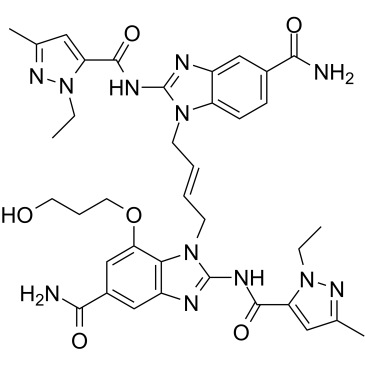| Cas No.: | 2138299-29-1 |
| Synonyms: | STING agonist 3 |
| SMILES: | C(C(N)=O)1=CC=C2N(C/C=C/CN3C4C(OCCCO)=CC(C(=O)N)=CC=4N=C3NC(=O)C3N(CC)N=C(C)C=3)C(NC(=O)C3N(CC)N=C(C)C=3)=NC2=C1 |
| Formula: | C37H42N12O6 |
| M.Wt: | 750.81 |
| Purity: | >98% |
| Sotrage: | 2 years -20°C Powder, 2 weeks4°C in DMSO,6 months-80°C in DMSO |
| Publication: | Ramanjulu JM et al. Design of amidobenzimidazole STING receptor agonists with systemic activity. Nature. 2018 Dec;564(7736):439-443. |
| Description: | STING agonist-3 is a selective small-molecule STING agonist. STING agonist-3 is a non-nucleotide STING agonist which has durable anti-tumor effect and tremendous potential to improve treatment of cancer[1]. |
| In Vivo: | STING agonist-3 (Compound 3) (subcutaneous injection; 2.5mg/kg) activates secretion of IFN-β, IL-6, TNF-α, and KC/GROα (CXCL1) in wild-type but not Sting−/− mice, induces STING-dependent activation of type-I interferon and pro-inflammatory cytokines in vivo[1]. STING agonist-3 (Compound 3) (subcutaneous injection; 3 mg/kg) exhibits systemic exposure with a half-life of 1.4 h and achieves systemic concentrations with EC50=200 ng /ml for mouse STING[1]. STING agonist-3 (Compound 3) (injection intravenously; 1.5 mg/kg) results in significant tumor growth inhibition, and improves survival with 8 out of 10 mice remaining tumors free at day 43[1]. Animal Model: Mice with approximately 100 mm3 subcutaneous CT-26 tumors[1] Dosage: 1.5 mg/kg Administration: Injection intravenously; 1.5 mg/kg; 1 day, 4 days, 8 days Result: Resulted in significant tumor growth inhibition. |
| In Vitro: | STING agonist-3 (Compound 3) induces dose-dependent activation of STING and secretion of IFN-β with ECapp50s of 130 nM,186 nM in human PBMCs and Mouse PBMCs[1]. |
| References: | [1]. Ramanjulu JM et al. Design of amidobenzimidazole STING receptor agonists with systemic activity. Nature. 2018 Dec;564(7736):439-443. |

 To enhance service speed and avoid tariff delays, we've opened a US warehouse. All US orders ship directly from our US facility.
To enhance service speed and avoid tariff delays, we've opened a US warehouse. All US orders ship directly from our US facility.




















